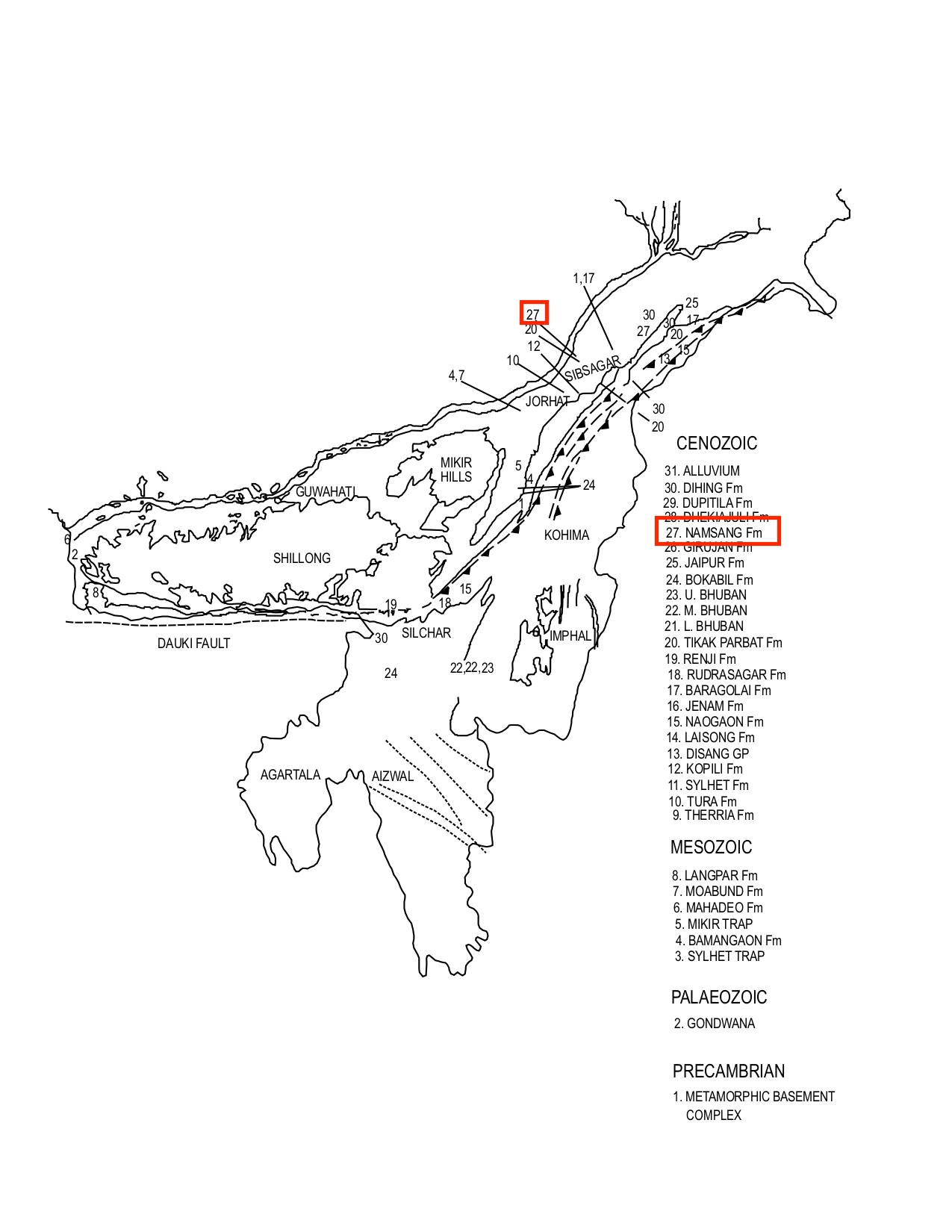Namsang Fm
Type Locality and Naming
Upper formation of Tipan Gr or lower formation of Moran Gr, depending upon local usage. The type section is in Dihing River section. [Original Publication: Evans, P. (1932) Tertiary succession in Assam, Trans. Min. Geol. Insti, India, Vol. 27, pp: 173-200.]. Reference well: Well Disangmukh-1, depth interval: 1393 - 1514 m; Well Nazira-1, depth interval: 1370 - 1923 m; Well Demalgaon-7, depth interval: 1570 - 2064 m. In the shelf area the formation is exposed in the Dhansiri Valley along the fringe of the Mikir and Naga Hils. In the subsurface it is recorded from Rajaphe Well 1 in the southwest in Dhansiri Valley, till Kumachai in the northeast near the Mishmi Hills by Deshpande et al., 1993.
Synonyms: Namsang Sandstone Fm. Evans (1932), redefined by Bhandari, Fuloria and Sastri (1973); Evans (1932) named a sequence of sandstones with clays and lignitic pebbles as the Num Rong Khu stage from the Dihing river section which he later renamed as the Namsang Beds, recognizing a wide-spread unconformity between the Girujan and Namsang. Bhandari et al (1973) formally defined these sediments as the Namsang Formation. The Nazira Sandstone of Deshpande et al., (1993) is its junior synonym after the mappability of the Namsang is well established in Upper Assam subsurface.
[Figure 1: Geological set up and formation stratotypes of North East Basins (modified after Pandey and Dave, 1998)]
Lithology and Thickness
Sandstone. In the type section, the formation is mainly arenaceous, but sandy mottled clay and clay beds occur at intervals. The clays exhibit green, grey and brown mottling, with sometimes reddish purple bands. Sand-rich lower part of the formation is usually greenish blue and fine grained. In the upper part of the formation, the rocks are coarser and either bluish-grey or whitish grey, weathering to orange-brown. Grit beds are common in the upper part. In the reference section, it comprised of massive-bedded sandstone with intercalated clay beds. The sandstones are loose, light colored and are often associated with carbonized woody fragments, often silty and clayey. The clays are bluish to dark grey or occasional red, often sticky and contain carbonaceous matter. (Deshpande et al., 1993). In the surface exposures, the thickness is more than 200 m. In the subsurface the thickness varies between 140 m (Geleki Well 126) to 712 m (Mariani Well 1). The overall thickness increases away from the Naga Thrust to Upper Assam.
Relationships and Distribution
Lower contact
It unconformably overlies the Girujan Fm Clay.
Upper contact
It is disconformably overlain by Dhekiajuli Fm, or by the Dupitila Fm (usage in SE Bangladesh)
Regional extent
Mikir Hills, Dhansiri Valley, Upper Assam Shelf, Naga Schuppen Belt, SE Bangladesh: It is exposed in Schuppen Belt, from the Mishimi Thrust in the northeast till near the junction of the Haflong and Disang thrusts in the southwest. The exposures are restricted to the outermost thrust sheets, mainly between the Naga and Cholimsen thrusts. It is also exposed in Mikir Hills, and Upper Assam Shelf. In the southerly area of Upper Assam, the Namsang Fm Sandstone merges with the Jaipur Fm Sandstone to form Tipam Group indifferentiated).
GeoJSON
Fossils
The Namsang sands are devoid of fossils with the exception of rare palynofossils.
Age
Depositional setting
Additional Information
